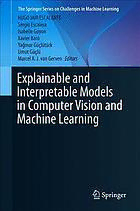
Explainable and interpretable models in computer vision and machine learning PDF
Preview Explainable and interpretable models in computer vision and machine learning
The Springer Series on Challenges in Machine Learning Hugo Jair Escalante · Sergio Escalera Isabelle Guyon · Xavier Baró Yağmur Güçlütürk · Umut Güçlü Marcel van Gerven Editors Explainable and Interpretable Models in Computer Vision and Machine Learning The Springer Series on Challenges in Machine Learning Serieseditors HugoJairEscalante,INAOE,Puebla,Mexico IsabelleGuyon,INRIA,UniversitéParisSud,UniversitéParisSaclay,Paris,France andChaLearn,Berkeley,CA,USA SergioEscalera,UniversityofBarcelona,Barcelona,Spain Thebooksofthisinnovativeseriescollectpaperswrittenbysuccessfulcompetitions inmachinelearning.Theyalsoincludeanalysesofthechallenges,tutorialmaterial, datasetdescriptions,andpointerstodataandsoftware.Togetherwiththewebsites ofthechallengecompetitions,theyofferacompleteteachingtoolkitandavaluable resourceforengineersandscientists. Moreinformationaboutthisseriesathttp://www.springer.com/series/15602 Hugo Jair Escalante (cid:129) Sergio Escalera Isabelle Guyon (cid:129) Xavier Baró (cid:129) Yag˘mur Güçlütürk Umut Güçlü (cid:129) Marcel van Gerven Editors Explainable and Interpretable Models in Computer Vision and Machine Learning 123 Editors HugoJairEscalante SergioEscalera INAOE UniversityofBarcelona Puebla,Mexico Barcelona,Spain IsabelleGuyon XavierBaró INRIA,UniversitéParisSud,Université OpenUniversityofCatalonia ParisSaclay,Paris,France Barcelona,Spain ChaLearn UmutGüçlü Berkeley,CA,USA RadboudUniversityNijmegen Nijmegen,TheNetherlands Yag˘murGüçlütürk RadboudUniversityNijmegen Nijmegen,TheNetherlands MarcelvanGerven RadboudUniversityNijmegen Nijmegen,TheNetherlands ISSN2520-131X ISSN2520-1328 (electronic) TheSpringerSeriesonChallengesinMachineLearning ISBN978-3-319-98130-7 ISBN978-3-319-98131-4 (eBook) https://doi.org/10.1007/978-3-319-98131-4 LibraryofCongressControlNumber:2018962179 ©SpringerNatureSwitzerlandAG2018 Thisworkissubjecttocopyright.AllrightsarereservedbythePublisher,whetherthewholeorpartof thematerialisconcerned,specificallytherightsoftranslation,reprinting,reuseofillustrations,recitation, broadcasting,reproductiononmicrofilmsorinanyotherphysicalway,andtransmissionorinformation storageandretrieval,electronicadaptation,computersoftware,orbysimilarordissimilarmethodology nowknownorhereafterdeveloped. Theuseofgeneraldescriptivenames,registerednames,trademarks,servicemarks,etc.inthispublication doesnotimply,evenintheabsenceofaspecificstatement,thatsuchnamesareexemptfromtherelevant protectivelawsandregulationsandthereforefreeforgeneraluse. Thepublisher,theauthors,andtheeditorsaresafetoassumethattheadviceandinformationinthisbook arebelievedtobetrueandaccurateatthedateofpublication.Neitherthepublishernortheauthorsor theeditorsgiveawarranty,expressorimplied,withrespecttothematerialcontainedhereinorforany errorsoromissionsthatmayhavebeenmade.Thepublisherremainsneutralwithregardtojurisdictional claimsinpublishedmapsandinstitutionalaffiliations. ThisSpringerimprintispublishedbytheregisteredcompanySpringerNatureSwitzerlandAG Theregisteredcompanyaddressis:Gewerbestrasse11,6330Cham,Switzerland Foreword “Toomuchofablackboxtome”.Thatisanoftenheardandlong-standingcriticism of data-drivenmachine learning methods, in general, and (deep) neuralnetworks, inparticular.Nevertheless,astoundingresultshavebeenobtainedwiththeseblack boxes. Interestingly, one could argue that this is, to a large extent, not in spite of but ratherthankstotheirblackboxnature:researchersnolongeraimatfullcontrolover themodelintrinsics,acommonpracticeinthehand-craftedfeaturesera.Instead,the dataleadstheway,optimisingthewholesysteminanend-to-endmannerforthetask athand,yieldingsuperiorresults. The flip side of the coin is that, giventhe complexityof the modelsused these days,with millionsofparameters,itishardto understandthe processesinsidethe box. As a consequence,the question rises whether such systems can be trusted at all–especiallywhenitcomestosafety-criticalapplicationssuchasself-drivingcars ormedicalimageinterpretation. Three more observations further add to this scepticism. First, networks often struggle to generalise beyond the circumstances seen at training time. Yet, they keepmaking(oftenwrong)predictionswithhighconfidenceforout-of-distribution samples. Second, there is the issue with adversarial examples, where it has been shownthataddingrelativelylowamountsofnoisesufficestochangetheoutputof aneuralnetworkinanarbitrarypredefineddirection.Finally,withartificialsystems reachingorevensurpassinghumanperformance,thelong-standingcriticismofthe blackboxapproachnowbecomesmorerelevantthanever. After the initial enthusiasm at the start of the third summer of AI about the goodperformanceobtainedwithdeeplearning,moreandmoreconcernsareraised along the lines sketched above. As a countermeasure, we need more research towardsmodelexplainabilityandinterpretability.Letusbuildanewgenerationof machine learning models that are capable not only of predicting the output with high accuracybut also of explainingthe producedresult and enablingresearchers to interpret the learned models. This is a challenging endeavour, with several openresearchquestions:Howtovisualiseorcommunicatemodelexplanationsand interpretations with the user? How to avoid a misguided feeling of trust? How v vi Foreword to evaluate model explanations and interpretations? How to avoid or deal with subjectivity in this matter? Within this book, a fine collection of the current state oftheartinthisdirectionisbroughttogether,highlightingdifferentapproachesto tackletheproblem. KULeuven,Flanders,Belgium TinneTuytelaars June2018 Preface Researchprogressincomputervisionandpatternrecognitionhasledtoavarietyof modellingtechniqueswith (almost) human-likeperformancein a variety of tasks. A clear example of this type of models is neural networks, whose deep variants dominatethe arenasof computervision amongother fields. Althoughthis type of modelshasobtainedastoundingresultsinavarietyoftasks(e.g.facerecognition), theyarelimitedintheirexplainabilityandinterpretability.Thatis,ingeneral,users cannotsaytoomuchabout: (cid:129) Whatistherationalebehindthedecisionmade?(explainability) (cid:129) Whatinthemodelstructureexplainsitsfunctioning?(interpretability) Hence,while goodperformanceis a criticalrequiredcharacteristicforlearning machines,explainability/interpretabilitycapabilitiesarehighlyneededifonewants to take learning machines to the next step and, in particular, include them into decision support systems involving human supervision (for instance, in medicine orinsecurity).Becauseoftheircriticalimportance,thereisaresearchtrendwithin thecomputervisionandmachinelearningcommunitiesinstudyingbothaspects.In fact,inrecentyears,muchworkhasbeendevotedtodefiningwhatisexplainability and interpretability in the context of models and how to evaluate these aspects, proposing and analysing mechanisms for explaining recommendations of models andinterpretingtheirstructure. All this progress puts us in perfect time to compile in a single book the latest research advanceson explainableand interpretablemodelsin the contextof computervisionandmachinelearning.Thebookisdividedintofourpartsthatcover complimentaryandrelevanttopicsaroundthissubject. Part I focuseson generalnotionsand conceptsaroundexplainabilityand inter- pretability.F.Doshi-VelezandKimelaborateonconsiderationsfortheevaluationof interpretablemachinelearningmodels.Theyprovideadefinitionofinterpretability, principlesforevaluationandataxonomyofevaluationapproaches.Theyconclude with recommendations for researchers in the field. In the same line, Ras et al. elaborateonissuesregardingdeeplearningandexplainability,tryingtobridgeagap vii viii Preface betweenexpertusersandlay/averageusers.Theydiscusstherelationbetweenusers lawsandregulations,explanationsandmethodsinthecontextofexplainability. The secondpart of the bookis devoted to chaptersthat focuson explainability andinterpretabilityfromthemachinelearningpointofview.Goudetetal.describe Causal GenerativeNeuralNetworks,a methodologyto infercausal relationsfrom observationaldata.Morespecifically,theyprovideameanstoestimateagenerative modelofthejointdistributionofobservedvariables.Sincecausalityistheultimate explanatory mechanism desired for most modelling techniques, this methodology can have a great impact into the field. Loza Mencia et al. contribute to the book with a chapter on rule-based methods for multi-label classification. The chapter emphasises the interpretability characteristics of rule-based approaches to multi- label classification, and two approachesfor learning predictive rule-based models are reviewed in detail. Rieger et al. study the relationship between performance and quality of explainability in the context of deep neural networks. They aim to determinewhetherexplanationsexhibitasystematic biasandhowthestructureof theneuralnetworkcanbeadaptedtoreducesuchbias. The third part of the book focuses on explainability and interpretability in computer vision. Akata el al. describe a novelmethodologyfor generatingexpla- nations in image-object classification. The key features of the proposed method are a relevance loss that conditions sentence generation on the image category and, on the other hand, a discriminative loss inspired on reinforcement learning that relies on a sentence classifier. N. Fatema and R. Mooney present a novel methodologyto generateexplanationsforensemblesof visualquestionanswering (VQA) systems. In addition, two evaluation protocols are described and used to evaluate explanations generated by their ensemble. This is among the first works dealing with explanation of ensembles of VQA systems.J. Kim and J. Canny describeamethodologyforgeneratingvisuallyinterpretableimagesinthecontext ofautonomousvehicledriving.Themethodologycomprisestwosteps:aCNNwith attentionmodelthathighlightspotentiallysalientregionsin imagesanda filtering stepthataimsatremovingspurioussalientregions.Themethodologyisextensively evaluated,comprisingqualitativeandquantitativeassessments. Last but not least, Part IV covers methodologies related to explainability and interpretability in the context of first impressions and job candidate screening. Liemet al. elaborateon the gapbetweenmachinelearning(andcomputerscience in general) and psychology in the context of job candidate screening. Through a detailed review, the authors try to fill an understanding gap between both areas. Liem at al. describe their solution to the job candidate screening competition. H. KayaandA.Salahdescribethewinningmethodologyofthejobcandidatescreening competition.Theauthorsfocuson theexplanatorycharacteristicsoftheir solution anddiscussthe potentialbiasof theirmodel.Similarly,Aakuretal. describetheir winning methodology for the explainable job candidate screening challenge. The authorsprovideandetaileddescriptionoftheirmethodandanindepthanalysisof theirresults. Preface ix To the best of our knowledge, this is the first compilation of research on this topic.Wewerefortunatetogather11chaptersofextraordinaryqualitythat,together, captureasnapshotofthestateoftheartinthisprettymuchimportanttopic. Puebla,Mexico HugoJairEscalante Barcelona,Spain SergioEscalera Paris,France IsabelleGuyon Barcelona,Spain XavierBaró Nijmegen,TheNetherlands Yag˘murGüçlütürk Nijmegen,TheNetherlands UmutGüçlü Nijmegen,TheNetherlands MarcelvanGerven June2018
